Sapper
A sapper, also called pioneer or combat engineer, is a combatant or soldier who performs a variety of military engineering duties such as breaching, demolitions, bridge-building, laying or clearing minefields, field defenses as well as building, road and airfield construction and repair. They are also trained to serve as infantry personnel in defensive and offensive operations. A sapper's duties are devoted to tasks involving facilitating movement, defence and survival of allied forces and impeding those of enemies.
The term "sapper" is used in the British Army and Commonwealth nations, Polish Army and the U.S. military. The phrase "sapper" comes from the French saper (to undermine, to dig under a wall or building to cause its collapse).
Historical origin
Sapper
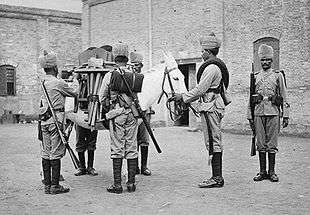
A sapper, in the sense first used by the French military, was one who excavated trenches under defensive musket or artillery fire to advance a besieging army's position in relation to the works of an attacked fortification, which was referred to as sapping the enemy fortifications.
Saps were excavated by brigades of trained sappers or instructed troops. When an army was defending a fortress with cannon, they had an obvious height and therefore range advantage over the attacker's guns. The attacking army's artillery had to be brought forward, under fire, so as to facilitate effective counter-battery fire.
This was achieved by digging what the French termed a sappe (derived from the archaic French word for spade). Using techniques developed and perfected by Vauban, the sappers began the trench at such an angle so as to avoid enemy fire enfilading the sappe. As they pressed forward, a position was prepared from which cannon could suppress the defenders on the bastions. The sappers would then change the course of their trench, zig-zagging toward the fortress wall.
Each leg brought the attacker's artillery closer until the besieged cannon would be sufficiently suppressed for the attackers to breach the walls. Broadly speaking, sappers were originally experts at demolishing or otherwise overcoming or bypassing fortification systems.
Miner
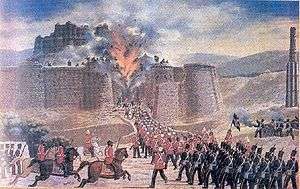
An additional term applied to sappers of the British Indian Army was 'miner'. The native engineer corps were referred to as 'sappers and miners', as for example, the Royal Bombay Sappers and Miners. The term arose from a task done by sappers to further the battle after saps were dug. The saps permitted cannon to be brought into firing range of the besieged fort and its cannon, but often the cannon themselves were unable to breach the fort walls. The engineers would dig a tunnel from the forward-most sap up to and under the fort wall, then place a charge of gunpowder and ignite it, causing a tremendous explosion which would destroy the wall and permit attacking infantry to close with the enemy. This was dangerous work, often lethal to the sappers, and was fiercely resisted by the besieged enemy. Since the two tasks went hand in hand and were done by the same troops, native Indian engineer corps came to be called 'sappers and miners'.
Specific usage
Commonwealth of Nations
Sapper (abbreviated Spr) is the Royal Engineers' equivalent of private. This is also the case within the Pakistan Army Corps of Engineers, Indian Army Corps of Engineers, Royal Canadian Engineers, Royal Australian Engineers,[1] South African Army Engineer Formation and Royal New Zealand Engineers. The term 'sapper' was introduced in 1856 when the Corps of Royal Sappers and Miners was amalgamated with the officer corps of the Royal Engineers to form the Corps of Royal Engineers.
Australia

During the Sinai and Palestine Campaign of World War I Australian sappers repaired a bridge at the historic crossing of the Jordan River at Jisr Benat Yakub (also known as Jacob's Ford). Here the retreating Ottoman and German rearguard had blown up the bridge's central arch which was repaired in five hours by sappers attached to the Australian Mounted Division. While the light horse brigades forded the river, continuing the Desert Mounted Corps' advance to Damascus, the sappers worked through the night of 27/28 September 1918, to repair the bridge to enable the division's wheeled vehicles and guns to follow on 28 September.[2][3][4] Australian Sappers in the Vietnam War were also honoured in the Cold Chisel song Khe Sanh with the line "I left my heart to the Sappers round Khe Sanh".
Canada
In the Canadian Forces, sappers exist both in the regular force and reserve force. The rank of sapper is used instead of private trained to signify completion of the Engineer DP1 course. Canadian sappers have been deployed in many major conflicts in recent history including World War I, World War II, the Korean War, and the War in Afghanistan. The roles of a sapper entail: Bridge building with the ACROW or Bailey bridging systems; explosive ordnance disposal; operating the advanced reverse-osmosis water purification unit, used mainly in domestic operations; maintaining roadways and airfields; combat diving; tactical breaching; and erecting and tearing down friendly living spaces. Ultimately, the objective of the sappers is to facilitate the living, moving, and fighting for friendly troops on the battlefield, and denying the same to enemy forces. The motto of the Canadian Military Engineers is Ubique (Latin: everywhere) a motto shared with the Royal Canadian Artillery. The patron saint of combat engineers is Saint Barbara, and 4 December is the corps' day of celebration.
Indian Army
The term 'sappers', in addition to the connotation of rank of engineer private, is used collectively to informally refer to the Engineer Corps as a whole and also forms part of the informal names of the three combat engineer groups, viz. Madras Sappers, Bengal Sappers and the Bombay Sappers. Each of these groups consist of about twenty battalion-sized engineer regiments and additional company-sized minor engineer units. The three sapper groups are descended from the sapper and miner groups of the East India Company and later the British Indian Army of the British Raj.
Israel
In the Israel Defense Forces a sapper (in Hebrew: פלס, palas) is the military profession of a combat soldier who went through basic combat engineering training. Most of the sappers are soldiers of the Combat Engineering Corps, but there are also infantry sappers, who are part of the infantry brigades and are organized in engineering companies called פלחה"ן (palchahan). These companies are integral part of the infantry brigades. Combat engineering corps sappers are arranged in battalions.
Each sapper goes through high level infantry training, which qualifies him as rifleman 07 (רובאי 07). Combat engineering sappers are qualified as 'sapper 06' (פלס 06). They are skilled in infantry combat, basic sabotage, landmine planting and demining, use of explosives, breaching and opening routes, trench warfare, and operating the IDF Puma combat engineering vehicle. Combat engineering commanders are qualified as 'sapper 08' while combat engineering officers are qualified as sapper 11'. Both go through additional advance training to gain the skills needed for high level sapper profession.
The Israel Police also maintains a bomb disposal specialist unit. All police sappers must graduate from a 10-month training program at the bomb disposal training center in Beit Shemesh, which includes operational exercises, theoretical studies, and fieldwork.[5]
France
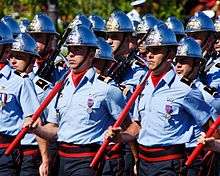
In France, civil firefighters and the military firefighters of the Paris Fire Brigade and other town or country brigades are called "sappers-firemen" (sapeurs-pompiers, abbreviated 'SP'): the first fire company created by Napoléon I was a military sapper company. Apart from this, the sappers are the combat engineers.
Sappers were very common in the French army and in other European armies during the Napoleonic era, but progressively disappeared in the 19th century. The French Foreign Legion is an exception, and retains a sapper unit.
Since the 18th century, every grenadier battalion in the French Army had a small unit of sappers. They had the mission to advance under enemy fire in order to destroy the obstacles drawn by the enemy and to clear the way for the rest of the infantry. The danger of such missions resulted in sappers having short life expectancies. Because of this, the army allowed them certain privileges such as the authorization to wear beards. In addition to their beards and axes, they traditionally wear leather aprons and gloves.
The current pioneer unit of the Legion reintroduced the symbols of the Napoleonic sappers: the beard, the axe, the leather apron, the crossed-axes insignia and the leather gloves. If the parades of the Legion are opened by this unit, it is to commemorate the traditional role of the sappers "opening the way" for the troops.
Greece
In the Hellenic Army, there is the "mechanic" or "Corps of Engineers" (μηχανικό; michaniko).
Portugal
In Portugal, the term "sapper" is used both in the military and in the civilian environment.
In the Portuguese Army, a sapador de engenharia (engineering sapper) is a soldier of the engineer branch that has specialized combat engineer training. A sapador de infantaria (infantry sapper) is a soldier of the infantry branch that has a similar training and that usually serves in the combat support sapper platoon of an infantry battalion. A sapador NBQ (NBC sapper) is an engineer branch soldier specialized in nuclear, biological and chemical warfare.
The bombeiros-sapadores ("sapper-firefighters") are the civil municipal professional firefighters that exist in the main cities of the country. The largest unit of this type is the Regimento de Bombeiros Sapadores ("sapper-firefighters regiment") maintained by the Lisbon municipal council.
The sapadores florestais (forest sappers) are the professionals maintained by the Government, local authorities and large private forestry companies, whose function is to clean and maintain forests and to prevent and fight forest fires.
Pakistan Army
In the Pakistan Army, Sapper officers perform duties as both combat engineers as well as normal engineer duties. The Corp is led by Engineer-in-Chief who is a Lt Gen. The current Engineer-in-Chief is Lt Gen Khalid Asghar.
The Frontier Works Organization, Military Engineering Service and the Survey of Pakistan is part of the corp.
Initially part of the Indian Corps of Engineers, it dates back to 1780 but came to its modern form in 1947 following the Independence of Pakistan. Since then it has taken part in all wars including 1965 War, 1971 War and Kargil War. It has completed the Pakistan portion of Karakoram Highway. The corp is actively taking part in Operation Zarb-e-Azb
United States Army
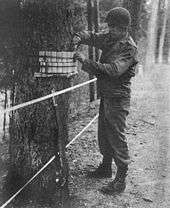
In the U.S. Army, sappers are combat engineers who support the front-line infantry, and they have fought in every war in American history. For example, after the Battle of Yorktown, General Washington cited Louis Lebègue Duportail, the Chief of Engineers, for conduct which afforded "brilliant proofs of his military genius."
Designation as a sapper nowadays is earned as an additional proficiency. The U.S. Army authorizes four skill tabs[6] for permanent wear above the unit patch on the left shoulder (Army Regulation 670-1 Chapter 29-13, Sub-Paragraph f). Along with the Sapper Tab, the Special Forces Tab, the Ranger Tab, and the President's Hundred Tab identify soldiers who have passed a demanding course of military instruction and demonstrated their competence in particular specialities and skills.
To wear the Sapper Tab, a soldier must graduate from the sapper leader course which is operated by the U.S. Army Engineer School at Fort Leonard Wood, Missouri. The sapper leader course is a 28-day course designed to train joint-service leaders in small unit tactics, leadership skills, and tactics required to perform as part of a combined arms team. The course is open to enlisted soldiers in the grades of E-4 (P) (in the army, specialist on the list for promotion to sergeant) E-5, and above, cadets, and officers O-3 (army captain) and below. Students can come from any combat or combat support branch of the service, but priority is given to engineering, cavalry, and infantry soldiers.[7]
PAVN and Viet Cong
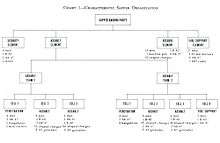
PAVN (People's Army of Vietnam) and Viet Cong sappers, as they were called by US forces, are better described as commando units. The Vietnamese term đặc công can be literally translated as "special task". Thousands of specially trained elite fighters served in the PAVN and Viet Cong commando–sapper units which were organized as independent formations. While not always successful due to lack of appropriate personal weapon types for combat and assault like other special forces, at times they inflicted heavy damage against their enemies. They have been armed with various types of bombs, mines, explosive charges, grenades and even steel-pellet mines which were much more devastating than the U.S. M18 Claymore and are still the main weapons of the đặc công.
These elite units served as raiders against American/ARVN troops, and infiltrated spearheads during the final Ho Chi Minh Campaign in 1975 – where they seized key road and bridge assets, destroyed installations, attacked command and control nodes located deep inside enemy territory, planted explosives on U.S. water craft, and otherwise helped the PAVN's rapid mobile forces advance. A typical PAVN/VC đặc công organization is shown in the diagram. The raiding force was usually grouped into assault teams, each broken down into several 3–5 man assault cells. Overall, there were generally 4 operational echelons.[8]
Honours
Sapper Island, St. Joseph Channel, Algoma District, Ontario was named in honour of sappers, especially those who graduated from the Royal Military College of Canada.[9] 46°18′56″N 83°57′29″W / 46.31556°N 83.95806°W
See also
- Assault pioneer
- List of military engineer nomenclatures
- Trooper (rank)
- Viet Cong and PAVN Sapper attacks
References
Citations
- ↑ Jobson 2009, p. 96.
- ↑ Preston pp. 261–2
- ↑ Carver 2003 p. 242
- ↑ Falls 1930 Vol. 2 p. 568
- ↑ Efraim, Omri (20 September 2011). "Israel Police get 1st female sapper". Israel News.
- ↑ AR 670-1: Wear and Appearance of Army Uniforms and Insignia U.S. Army, revised: 11 May 2012.
- ↑ Sapper Course, US Army, archived from the original on 9 September 2006
- ↑ Ott 1975, pp.1–42.
- ↑ Ontario History, Papers and Records, Vol. X, Ontario Historical Society, 1913. Retrieved 28 October 2010.
Bibliography
- Carver, Michael, Field Marshal Lord (2003). The National Army Museum Book of The Turkish Front 1914–1918: The Campaigns at Gallipoli, in Mesopotamia and in Palestine. London: Pan Macmillan. ISBN 978-0-283-07347-2.
- Falls, Cyril; A. F. Becke (maps) (1930). Military Operations Egypt & Palestine from June 1917 to the End of the War. Official History of the Great War Based on Official Documents by Direction of the Historical Section of the Committee of Imperial Defence. 2 Part II. London: H.M. Stationery Office. OCLC 256950972.
- Jobson, Christopher (2009). Looking Forward, Looking Back: Customs and Traditions of the Australian Army. Wavell Heights, Queensland: Big Sky Publishing. ISBN 978-0-9803251-6-4.
- Ott, David Ewing, (1975). Vietnam Studies, Field Artillery, 1954–1973. Washington, D.C.: United States Army Center of Military History.
- Preston, R. M. P. (1921). The Desert Mounted Corps: An Account of the Cavalry Operations in Palestine and Syria 1917–1918. London: Constable & Co. OCLC 3900439.
External links
- Royal Engineers Museum – History of the Royal Engineers (The Sappers)
- Royal Engineers Museum – Origins of the term "Sapper"
- - Site for tracking down former members of the Royal Engineers.
- Dec 1918 Popular Science World War 1 article about a French engineer using a ground stethoscope to listen for German sappers – Listening to Enemy Sappers, Popular Science monthly, January 1919, page 27, Scanned by Google Books
- Sapper-Museum, virtual museum of Russian engineering troops
- A.-M. Zielenski , Colonel (sapper), Military Engineer